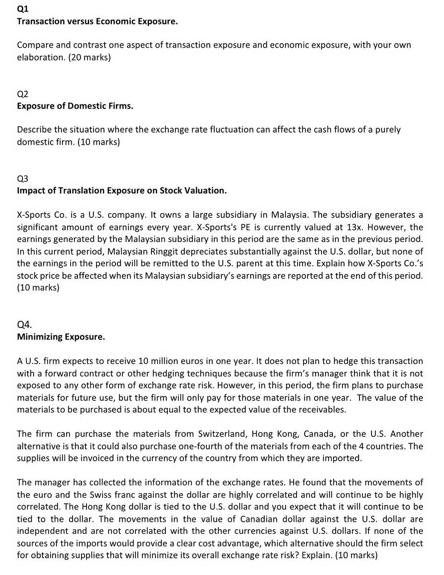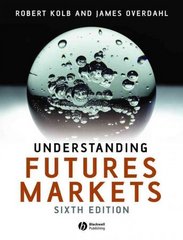
Q1 Transaction versus Economic Exposure. Compare and contrast one aspect of transaction exposure and economic exposure, with your own elaboration (20 marks) Q2 Exposure of Domestic Firms. Describe the situation where the exchange rate fluctuation can affect the cash flows of a purely domestic firm. (10 marks) Q3 Impact of Translation Exposure on Stock Valuation. X-Sports Co. is a U.S. company. It owns a large subsidiary in Malaysia. The subsidiary generates a significant amount of earnings every year. X-Sports's PE is currently valued at 13x. However, the earnings generated by the Malaysian subsidiary in this period are the same as in the previous period. In this current period, Malaysian Ringgit depreciates substantially against the U.S. dollar, but none of the earnings in the period will be remitted to the U.S. parent at this time. Explain how X-Sports Co.'s stock price be affected when its Malaysian subsidiary's earnings are reported at the end of this period. (10 marks) Q4. Minimizing Exposure. A U.S. firm expects to receive 10 million euros in one year. It does not plan to hedge this transaction with a forward contract or other hedging techniques because the firm's manager think that it is not exposed to any other form of exchange rate risk. However, in this period, the firm plans to purchase materials for future use, but the firm will only pay for those materials in one year. The value of the materials to be purchased is about equal to the expected value of the receivables. The firm can purchase the materials from Switzerland, Hong Kong, Canada, or the U.S. Another alternative is that it could also purchase one-fourth of the materials from each of the 4 countries. The supplies will be invoiced in the currency of the country from which they are imported. The manager has collected the information of the exchange rates. He found that the movements of the euro and the Swiss franc against the dollar are highly correlated and will continue to be highly correlated. The Hong Kong dollar is tied to the U.S. dollar and you expect that it will continue to be tied to the dollar. The movements in the value of Canadian dollar against the U.S. dollar are independent and are not correlated with the other currencies against U.S. dollars. If none of the sources of the imports would provide a clear cost advantage, which alternative should the firm select for obtaining supplies that will minimize its overall exchange rate risk? Explain. (10 marks) Q1 Transaction versus Economic Exposure. Compare and contrast one aspect of transaction exposure and economic exposure, with your own elaboration (20 marks) Q2 Exposure of Domestic Firms. Describe the situation where the exchange rate fluctuation can affect the cash flows of a purely domestic firm. (10 marks) Q3 Impact of Translation Exposure on Stock Valuation. X-Sports Co. is a U.S. company. It owns a large subsidiary in Malaysia. The subsidiary generates a significant amount of earnings every year. X-Sports's PE is currently valued at 13x. However, the earnings generated by the Malaysian subsidiary in this period are the same as in the previous period. In this current period, Malaysian Ringgit depreciates substantially against the U.S. dollar, but none of the earnings in the period will be remitted to the U.S. parent at this time. Explain how X-Sports Co.'s stock price be affected when its Malaysian subsidiary's earnings are reported at the end of this period. (10 marks) Q4. Minimizing Exposure. A U.S. firm expects to receive 10 million euros in one year. It does not plan to hedge this transaction with a forward contract or other hedging techniques because the firm's manager think that it is not exposed to any other form of exchange rate risk. However, in this period, the firm plans to purchase materials for future use, but the firm will only pay for those materials in one year. The value of the materials to be purchased is about equal to the expected value of the receivables. The firm can purchase the materials from Switzerland, Hong Kong, Canada, or the U.S. Another alternative is that it could also purchase one-fourth of the materials from each of the 4 countries. The supplies will be invoiced in the currency of the country from which they are imported. The manager has collected the information of the exchange rates. He found that the movements of the euro and the Swiss franc against the dollar are highly correlated and will continue to be highly correlated. The Hong Kong dollar is tied to the U.S. dollar and you expect that it will continue to be tied to the dollar. The movements in the value of Canadian dollar against the U.S. dollar are independent and are not correlated with the other currencies against U.S. dollars. If none of the sources of the imports would provide a clear cost advantage, which alternative should the firm select for obtaining supplies that will minimize its overall exchange rate risk? Explain. (10 marks)







